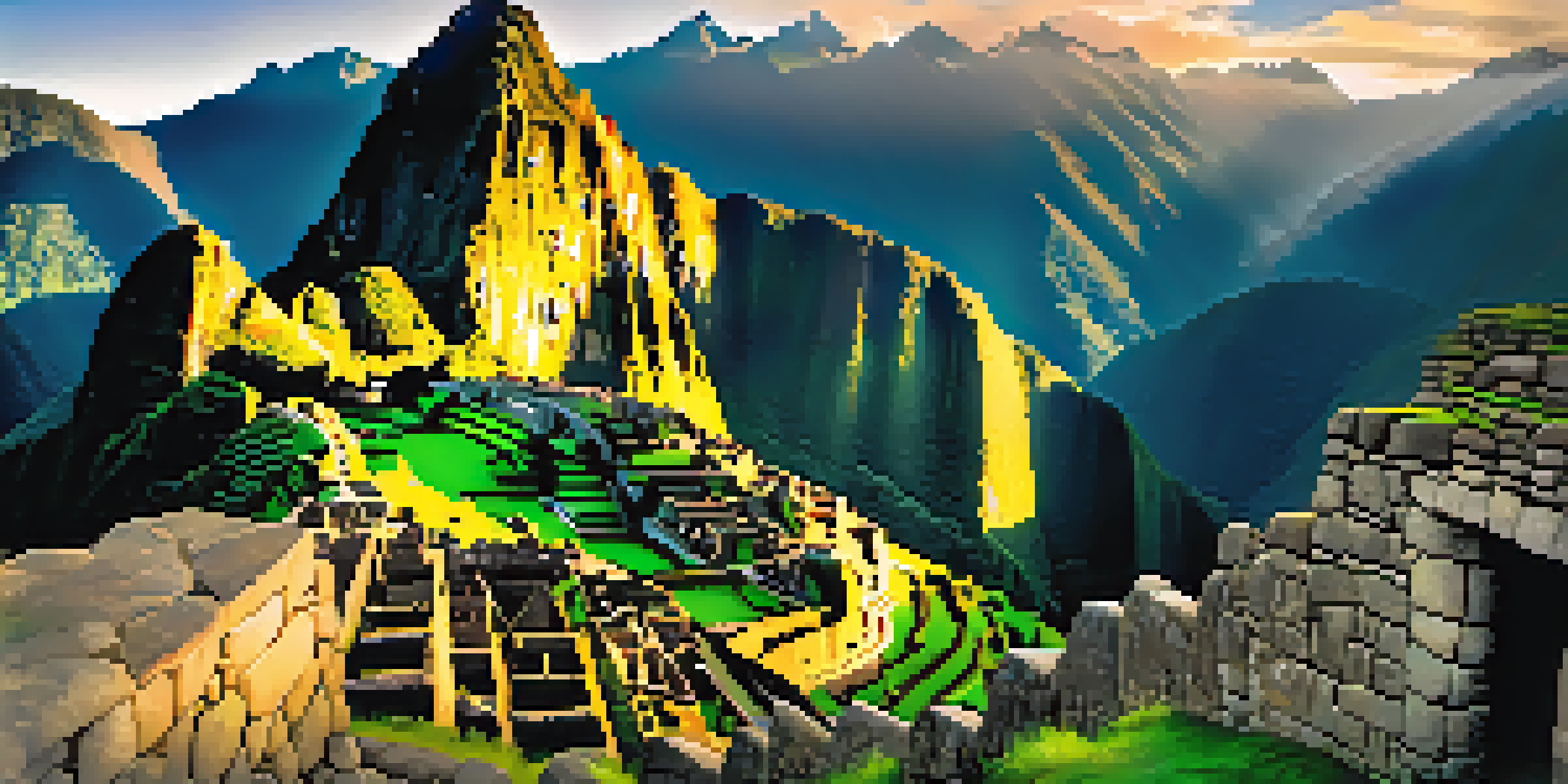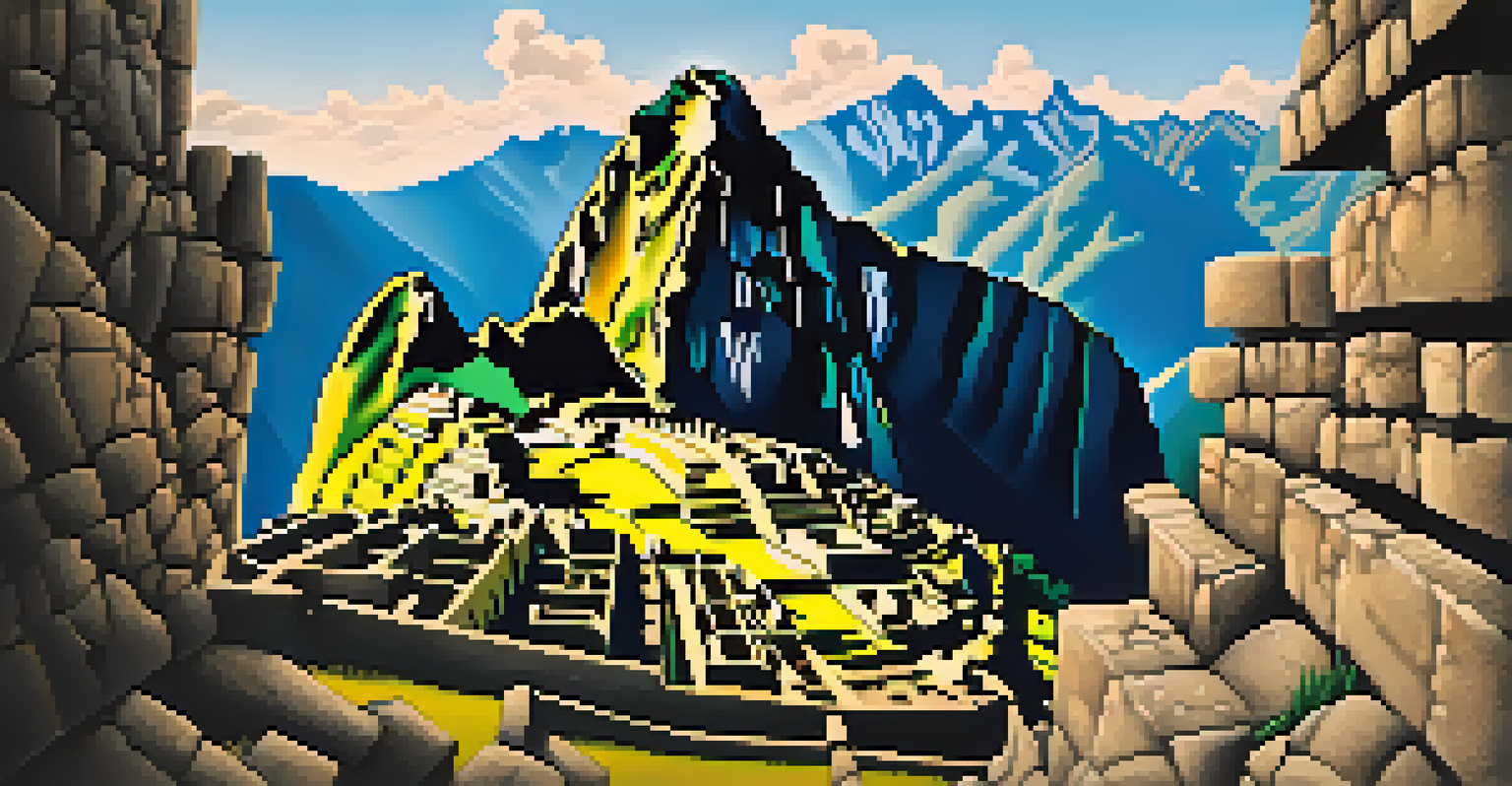Collaborative Efforts for Preserving Machu Picchu's Integrity

Understanding Machu Picchu's Cultural Significance
Machu Picchu is more than just a breathtaking ruin; it’s a symbol of Incan heritage. Nestled in the Andes, this UNESCO World Heritage Site attracts millions each year, eager to witness its stunning architecture and rich history. Its cultural significance is not only rooted in its historical importance but also in its representation of a civilization that thrived harmoniously with nature.
The preservation of cultural heritage is not merely a matter of conserving the past; it is about creating a sustainable future.
However, with such popularity comes the challenge of preservation. The influx of tourists poses a risk to the site's structural integrity and the surrounding ecosystem. Understanding this delicate balance is crucial for effective preservation efforts, as it guides collaborative initiatives aimed at safeguarding Machu Picchu for future generations.
As we delve into the collaborative efforts for its preservation, we recognize that the stakes are high. Protecting this iconic site requires a multifaceted approach that respects both its cultural and environmental dimensions. Together, we can explore how various stakeholders are joining forces to ensure Machu Picchu remains a marvel of history and nature.
Key Stakeholders in Preservation Efforts
Preserving Machu Picchu involves a diverse group of stakeholders, including the Peruvian government, local communities, tourists, and environmental organizations. Each player has a unique role that contributes to the overall mission of protecting this iconic landmark. The collaboration between these groups is essential to creating a sustainable model for tourism and conservation.

For instance, the Peruvian government implements regulations aimed at limiting visitor numbers and managing the impact on the site. Local communities are also crucial, as their involvement in tourism can lead to economic benefits while fostering a sense of ownership and responsibility towards the heritage. Environmental organizations often provide expertise and resources to address ecological concerns, ensuring that preservation efforts are holistic.
Machu Picchu's Cultural Importance
Machu Picchu is a UNESCO World Heritage Site that symbolizes Incan heritage and highlights the need for preservation amidst rising tourism.
This collective approach emphasizes that everyone has a stake in Machu Picchu’s future. By uniting diverse interests, stakeholders can work towards solutions that not only preserve the site but also enrich the lives of those who live and work in its shadow.
Innovative Conservation Techniques in Action
Advancements in technology have opened new avenues for the preservation of historical sites like Machu Picchu. Innovative conservation techniques, such as drone surveys and 3D imaging, allow for detailed monitoring of the site's condition without intrusive methods. These tools enable experts to assess structural integrity and plan necessary repairs while minimizing human impact.
We do not inherit the earth from our ancestors; we borrow it from our children.
Moreover, local artisans are getting involved in restoration projects, using traditional methods to maintain authenticity. This blend of modern technology and ancient craftsmanship not only preserves the site but also supports the local economy. By investing in these innovative strategies, stakeholders are creating a model that can be replicated in other heritage sites around the world.
Ultimately, these techniques highlight the importance of adaptability in preservation efforts. As conditions change, whether due to climate or tourism, the ability to respond with innovative solutions ensures that Machu Picchu can withstand the test of time.
Community Involvement in Sustainable Tourism
Engaging local communities in tourism initiatives is a cornerstone of sustainable practices around Machu Picchu. By involving community members, tourism can provide economic opportunities while fostering a sense of pride in their heritage. Programs that promote local craftsmanship and guided tours led by indigenous people enrich visitors' experiences and create a personal connection to the site.
Moreover, community-led initiatives often include education about the importance of preservation, encouraging responsible tourism among visitors. When tourists are informed about the impact of their actions, they can make choices that support conservation efforts, such as sticking to marked paths and minimizing waste.
Collaboration for Effective Preservation
Successful preservation of Machu Picchu relies on the combined efforts of the government, local communities, tourists, and environmental organizations.
This symbiotic relationship between tourists and locals not only helps sustain the site but also nurtures cultural exchange. Visitors leave with a deeper understanding of Machu Picchu’s significance, while local communities benefit from their presence in a respectful and sustainable manner.
Government Regulations and Their Impact
Government regulations play a pivotal role in the preservation of Machu Picchu, aiming to balance tourism and conservation. By implementing visitor caps and seasonal access restrictions, authorities can mitigate the wear and tear caused by foot traffic. These regulations are informed by ongoing research and monitoring of the site’s condition, ensuring that preservation is data-driven.
Additionally, the government collaborates with various organizations to create awareness campaigns that promote responsible tourism. These campaigns educate visitors about the importance of respecting the site and its surroundings, which is crucial for long-term sustainability. Such initiatives help cultivate a culture of responsibility among tourists, making them active participants in preservation.
While regulations can sometimes be met with resistance from tourism operators concerned about profits, a long-term view reveals their necessity. By prioritizing the integrity of Machu Picchu, the government ultimately safeguards the very resource that draws tourists in the first place.
The Role of Education in Preservation Efforts
Education is a powerful tool in the fight to preserve Machu Picchu. By raising awareness about the significance of the site and the challenges it faces, educational programs can inspire both locals and tourists to become advocates for preservation. Schools, museums, and tour operators are increasingly incorporating educational elements that highlight the importance of sustainable practices.
For example, workshops that focus on the history of the Incas and the environmental stewardship of the area can deepen visitors' appreciation for Machu Picchu. When tourists leave with a richer understanding of what they are experiencing, they're more likely to engage in responsible behavior during their visit. This proactive approach reinforces the idea that preservation is a shared responsibility.
Education Drives Sustainable Tourism
Educational initiatives inspire both locals and tourists to engage in responsible behaviors that support the preservation of Machu Picchu.
Moreover, such educational efforts can empower local communities, equipping them with knowledge and skills to advocate for their heritage. By fostering a culture of learning, we ensure that awareness and appreciation for Machu Picchu’s integrity are passed down through generations.
Future Challenges and Collaborative Solutions
As we look toward the future, numerous challenges loom over Machu Picchu's preservation efforts. Climate change poses a significant threat, leading to increased rainfall and erosion, while the ongoing popularity of the site continues to raise concerns about sustainability. Addressing these challenges requires ongoing collaboration among all stakeholders to develop innovative solutions.
One potential solution involves enhancing the infrastructure around the site to manage visitor flows more effectively. Improved pathways and designated viewing areas can help reduce environmental impact while still allowing tourists to experience the splendor of Machu Picchu. Additionally, investing in climate resilience strategies will be crucial to mitigate the effects of changing weather patterns.

Ultimately, the continued collaboration of government, local communities, and tourists will determine the future of Machu Picchu. By addressing challenges head-on and fostering a spirit of cooperation, we can ensure that this extraordinary site remains an enduring testament to the ingenuity of the Incan civilization.